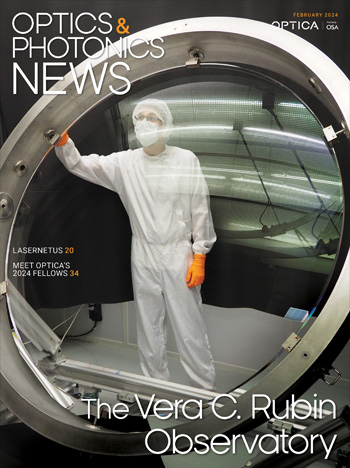
January 1995 Issue
- Optical Remote Sensing: Present Status and Future Direction
- Optical Environmental Monitoring in Industry
- 3-D Monitoring of Air Pollution Using Mobile All-solid-state Lidar System
- AVIRIS: A New Approach to Earth Remote Sensing
- The Earth Observing System: A Space-based Program for Assessing Mankind's Impact on the Global Environment
- When Snow Melts, Where Does the White Go?
- Browse all Issues
Feature Articles
Optical Remote Sensing: Present Status and Future Direction
Optical remote sensing (ORS) has become a valuable, if not indispensable tool for modern civilization for a number of reasons. ORS is often cost-effective compared with other techniques. Large geographical regions can be monitored quasi-continuously. Inaccessible or hazardous areas can be probed conveniently and safely.
by William B. GrantOptical Environmental Monitoring in Industry
Title I of the Clean Air Act (CAA) amendments of 1990 imposes upon industry and government the responsibility to gather data vital to the development of appropriate control strategies as well as to demonstrate compliance with the National Ambient Air Quality Standards (NAAQS). Title III of the Act requires ongoing programs to assess, reduce, and control hazardous air pollutants, while Title V requires the reduction, control, and monitoring of gases contributing to acidic aerosol production. One of the significant aspects of the CAA is its attention to multiple hazardous air pollutants (HAPS) rather than the more traditional focus on a limited number of so-called criteria pollutants. The Act imposes challenging air monitoring requirements, and it appears that traditional technologies may not be adequate to meet them.
by Robert L. Spellicy3-D Monitoring of Air Pollution Using Mobile All-solid-state Lidar System
Lidar is becoming a new reference method to monitor air pollution. Although decisive advantages like remote analysis and three-dimensional (3-D) mapping were demonstrated more than 20 years ago, lidar systems remained in the laboratory until now.
by J.P. WolfAVIRIS: A New Approach to Earth Remote Sensing
An imaging spectrometer measures a contiguous spectrum of light for each spatial element of an image. From these spectra, the constituents of the Earth's surface and atmosphere are identified and measured quantitatively based on the fundamental molecular absorption features and particle scattering characteristics. Spectra measured in the range of 400 to 2500 nm contain molecular absorption features for many constituents of the Earth's surface and atmosphere. Scientific investigations are ongoing using imaging spectrometry data in the disciplines of ecology, oceanography, coastal and inland waters, geology and soils, and snow hydrology, to name a few.
by Robert O. Green, M. Sarture, christopher J. Chovit, Jessica A. Faust, Pavel Hajek, and H. lan NovakThe Earth Observing System: A Space-based Program for Assessing Mankind's Impact on the Global Environment
These days, we frequently hear or read news about global warming, ozone depletion, acid rain, desertification, and loss of biodiversity, and wonder what the quality of life on Earth will be like in the future. Unfortunately, too few data currently exist to provide an adequate description. We know that there have been warming and cooling trends throughout the Earth's history, and that global climate change has arisen from natural causes. However, now there is compelling scientific evidence that global climate change is being accelerated by human activities.
by Michael D. King, David D. Herring, and David J. DinerWhen Snow Melts, Where Does the White Go?
The riddle-like nature of this question tickles me. How can something so bright leave no trace? (Grape juice won't do that.) We'll see the answer soon, and we'll have some fun in the kitchen. Let's first ask, "Is white a color?" In a sense it is, for it is all colors added together. That makes it a unique color, but it still obeys the color laws of addition and subtraction. Some nice experiments suggested in earlier "Light Touch" columns help illustrate these rules. White does give two unique results: A white object will return the color of any light shined on it unchanged, and white dilutes any pure colors mixed with it rather than creating a new color.

![A multiplexed image of a human tonsil acquired. [NIAID] using the iterative bleaching extends multiplexity (IBEX) method.](https://opnmedia.blob.core.windows.net/$web/opn/media/images/articles/2024/0424/departments/202404-cover-web.jpg?ext=.jpg)

